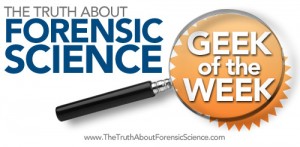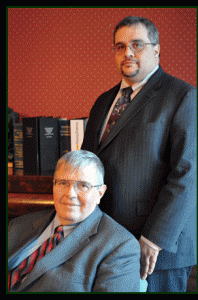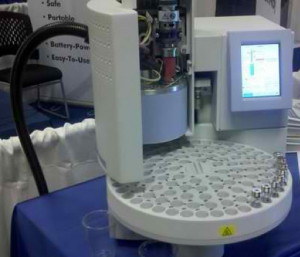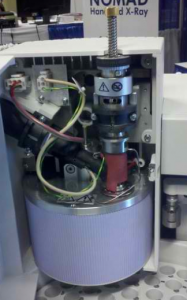The Forensic Science Geek of the Week
The week 34 “www.TheTruthAboutForensicScience.com Forensic Science Geek of the Week” honors goes to:
Brian Manchester, Esquire
Brian Manchester (pictured standing) is our Geek of the Week
About our winner:
Brian Manchester, Esquire is the managing partner of Manchester & Associates practicing with his father R. Bruce Manchester. According to their website: “The Law firm of Manchester & Associates is located in Bellefonte, PA in Central Pennsylvania. Our centralized location allows us to handle criminal defense cases throughout the State of Pennsylvania. At Manchester and Associates we understand when people find themselves accused or charged with a crime, they have numerous questions about the PA judicial system. We also understand how people can feel stressed or anxious and even depressed when criminal legal situations occur.” I know Brian and he is a very committed criminal defense practitioner.
Congratulations to our Week 35 winner!
All hail the www.TheTruthAboutForensicScience.com Forensic Science Geek of the Week!!!
See the challenge question that our winner correctly answered.
OFFICIAL QUESTION:
1. What is the top picture show?
2. What does the second picture show?
3. What type of analysis is this device used for?
Please visit the www.TheTruthAboutForensicScience.com FaceBook fan page.
Our Geek of the Week answered:
1. This device is called an auto-sampler. The carousel holds multiple vials full of samles. The carousel then rotates and individual vials are tested.
2. The second picture depicts the part of the auto-sampler where a sample is taken from the individual vials. The cylindrical part with the red bottom on the right hand side of the picture holds the device that picks up the headspace vials and this is where the needle that removes the headspace sample is also located.
3. This device is used in headspace gas chromotography (HS-GC). In headspace gas chromotography samples are prepared and put in sample vials. The sample vials are either crimped or have screw on caps. The vials are then placed in the carousel and heated until equilibrium is reached between the liquid part of the sample and the air above the liquid. The scientific principal behind this is based on Henry’s Law. Henry’s law states: at a constant temperature, the amount of a given gas dissolved in a given type and volume of liquid is directly proportional to the partial pressure of that gas in equilibrium with that liquid. The air above the sample is called the headspace.
Once equilibrium is reached the carousel is then rotated to the part of the auto-sampler depicted in picture number two. It is here that a needle is inserted through the septum located on the cap of the headspace vial. A sample of the headspace gas is then taken where it is transfered into the injection port of a gas chromoatograph for testing.
HS-GC is the method most often used for forensic testing for ETOH in blood samples.
[BLOGGER’S NOTE: Honorable mention should go to the following other folks who answered the question correctly (but just not first)…
Kelly W. Case, Esquire wrote: “The first pic is of the Perkin Elmer autosampler for a Gas Chromatograph. The sample tray heats and moves in a configuration allowing the samples to be tested in one complete batch. The second photo is the needle and mechanics driving the piercing mechanism in the sample to obtain a sample of the headspace gas, in blood testing, and then distributes the sample into the injector port of the GC machine, where testing begins. [T]his one of the uses of this testing is for testing blood for ethanol content. However, it’s use is not limited that that type of testing only. It is used to separate molecular compound into their individual components, allowing us to determine how much time it takes for an analyte to travel a specific distance with parameters of heat column length and flow rate all constant. Once the printout is obtained showing the amount of time that a given substance took to elute, that can be compared to known separation times for other substances to determine what the test substance was composed of.”
Ron Moore, Esquire wrote: “The first picture is a carousel for an autosampler. It looks a lot like the HS110 I used to use. The second picture is of the internal heater carousel that incubates 12 headspace vials prior to injection, and the crane that loads and unloads vials. We used to have crane errors when something got out of alignment. They are the sampling system for headspace gc, as done for alcohol analysis.”
Robert Lantz,, Ph.D. (2 weeks in a row he gets honorable mention) who wrote: “The top picture is of the autosampler tray for a GC (I am drawing a blank on the brand). The second shows, among other components, the stepper motor of the robotic injector tower. GC is used for a heap of analyses. The A/S vials are too small for use with headspace analysis, but would be used for liquid injection. This could be anything from ethanol in blood to much larger molecules, so long as they will evaporate.”
and
Josh Lee, Esquire who wrote: “1) The top picture is that of a Headspace Autosampler, carousel, and headspace vials. 2) The second picture shows the inside workings of the Autosampler. Inside there is an automated needle that will penetrate down into the headspace vials and draw in a sample and inject it into the device it is attached to; likely a Gas Chromatograph. 3) It is used for headspace testing of blood samples for drugs and alcohol of citizens accused of driving under the influence.”
You all are great! Thanks for answering too!]
The Hall of Fame for the www.TheTruthAboutForensicScience.com Forensic Science Geek of the Week:
Week 1: Chuck Ramsay, Esquire
Week 2: Rick McIndoe, PhD
Week 3: Christine Funk, Esquire
Week 4: Stephen Daniels
Week 5: Stephen Daniels
Week 6: Richard Middlebrook, Esquire
Week 7: Christine Funk, Esquire
Week 8: Ron Moore, B.S., J.D.
Week 9: Ron Moore, B.S., J.D.
Week 10: Kelly Case, Esquire and Michael Dye, Esquire
Week 11: Brian Manchester, Esquire
Week 12: Ron Moore, B.S., J.D.
Week 13: Ron Moore, B.S., J.D.
Week 14: Josh Lee, Esquire
Week 15: Joshua Dale, Esquire and Steven W. Hernandez, Esquire
Week 16: Christine Funk, Esquire
Week 17: Joshua Dale, Esquire
Week 18: Glen Neeley, Esquire
Week 19: Amanda Bynum, Esquire
Week 20: Josh Lee, Esquire
Week 21: Glen Neeley, Esquire
Week 22: Stephen Daniels
Week 23: Ron Moore, B.S., J.D.
Week 24: Bobby Spinks
Week 25: Jon Woolsey, Esquire
Week 26: Mehul B. Anjaria
Week 27: Richard Middlebrook, Esquire
WEEK 28: UNCLAIMED, IT COULD BE YOU!!!!
Week 29: Ron Moore, Esquire
Week 30: C. Jeffrey Sifers, Esquire
Week 31: Ron Moore, Esquire
Week 32: Mehul B. Anjaria
Week 33: Andy Johnston
Week 34: Ralph R. Ristenbatt, III
Week 35: Brian Manchester, Esquire






